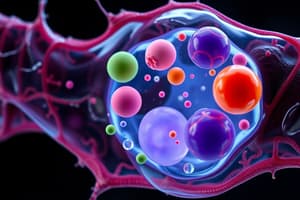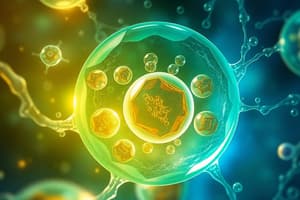Podcast
Questions and Answers
Which organelle is responsible for synthesizing proteins?
Which organelle is responsible for synthesizing proteins?
- Mitochondria
- Golgi apparatus
- Ribosomes (correct)
- Lysosomes
The smooth endoplasmic reticulum is studded with ribosomes.
The smooth endoplasmic reticulum is studded with ribosomes.
False (B)
What is the main function of the mitochondria?
What is the main function of the mitochondria?
To produce ATP through cellular respiration
The cell's genetic material, DNA, is stored in the ______.
The cell's genetic material, DNA, is stored in the ______.
Match the following organelles with their primary functions:
Match the following organelles with their primary functions:
Which of the following is NOT part of the cytoskeleton?
Which of the following is NOT part of the cytoskeleton?
The plasma membrane is a single layer of phospholipids.
The plasma membrane is a single layer of phospholipids.
What is the function of the nuclear pores present in the nuclear envelope?
What is the function of the nuclear pores present in the nuclear envelope?
Which of the following environments would you expect to find a halophile?
Which of the following environments would you expect to find a halophile?
Fungi are autotrophic organisms.
Fungi are autotrophic organisms.
What is the main component of a fungal cell wall?
What is the main component of a fungal cell wall?
Bacteria that require oxygen to respire are called ______ bacteria.
Bacteria that require oxygen to respire are called ______ bacteria.
Match the following terms with their definitions:
Match the following terms with their definitions:
Which of the following is NOT a characteristic of plant cells?
Which of the following is NOT a characteristic of plant cells?
Which of the following structures is NOT found in prokaryotic cells?
Which of the following structures is NOT found in prokaryotic cells?
All protists are unicellular
All protists are unicellular
What is the primary method of reproduction for bacteria?
What is the primary method of reproduction for bacteria?
Autotrophic organisms can produce their own nutrients.
Autotrophic organisms can produce their own nutrients.
Who is considered the father of taxonomy?
Who is considered the father of taxonomy?
The variety of genes in a population is called ______ diversity.
The variety of genes in a population is called ______ diversity.
Match the following organisms with their method of nutrition:
Match the following organisms with their method of nutrition:
The two-part naming system used in taxonomy is called ______ nomenclature.
The two-part naming system used in taxonomy is called ______ nomenclature.
Which of the following best describes the nutritional mode of a plant?
Which of the following best describes the nutritional mode of a plant?
Match the following taxonomic ranks with their correct order from broadest to most specific:
Match the following taxonomic ranks with their correct order from broadest to most specific:
Which of the following best describes the Biological Species Concept?
Which of the following best describes the Biological Species Concept?
Archaea do not have a cell wall
Archaea do not have a cell wall
Describe the characteristics of an animal cell
Describe the characteristics of an animal cell
Analogous structures have similar structures but different functions.
Analogous structures have similar structures but different functions.
Gymnosperms use ______ for reproduction.
Gymnosperms use ______ for reproduction.
What type of evidence does the study of internal cell structure fall under?
What type of evidence does the study of internal cell structure fall under?
Match the following with what they are known for:
Match the following with what they are known for:
Structures that exist but have no function are called ______ structures.
Structures that exist but have no function are called ______ structures.
Match the following feeding behaviors with their description:
Match the following feeding behaviors with their description:
According to DNA evidence, which of the following are fungi most closely related to?
According to DNA evidence, which of the following are fungi most closely related to?
Eubacteria are generally found in extreme conditions.
Eubacteria are generally found in extreme conditions.
Name the three basic shapes of bacteria.
Name the three basic shapes of bacteria.
Bacteria that produce methane as an anaerobic byproduct are called ______.
Bacteria that produce methane as an anaerobic byproduct are called ______.
Match the following prefixes to their corresponding numbers:
Match the following prefixes to their corresponding numbers:
Flashcards
What is the function of the nucleus?
What is the function of the nucleus?
The control center of the cell that stores genetic material (DNA) and regulates gene expression. It also directs protein synthesis.
What is the function of ribosomes?
What is the function of ribosomes?
The site of protein synthesis. They can be free-floating in the cytoplasm or attached to the rough endoplasmic reticulum.
What are the functions of the endoplasmic reticulum (ER)?
What are the functions of the endoplasmic reticulum (ER)?
A network of interconnected membranes that helps in protein synthesis, lipid synthesis, detoxification, and calcium storage.
What is the function of the Golgi apparatus?
What is the function of the Golgi apparatus?
Signup and view all the flashcards
What is the function of mitochondria?
What is the function of mitochondria?
Signup and view all the flashcards
What is the function of chloroplasts?
What is the function of chloroplasts?
Signup and view all the flashcards
What is the function of vacuoles?
What is the function of vacuoles?
Signup and view all the flashcards
What is the function of the cytoskeleton?
What is the function of the cytoskeleton?
Signup and view all the flashcards
Centrosome
Centrosome
Signup and view all the flashcards
Centrioles
Centrioles
Signup and view all the flashcards
Cell Wall
Cell Wall
Signup and view all the flashcards
Cytoplasm
Cytoplasm
Signup and view all the flashcards
Prokaryotic Cells
Prokaryotic Cells
Signup and view all the flashcards
Eukaryotic Cells
Eukaryotic Cells
Signup and view all the flashcards
Autotrophic
Autotrophic
Signup and view all the flashcards
Heterotrophic
Heterotrophic
Signup and view all the flashcards
Carl Linnaeus
Carl Linnaeus
Signup and view all the flashcards
Binomial Nomenclature
Binomial Nomenclature
Signup and view all the flashcards
Dichotomous Key
Dichotomous Key
Signup and view all the flashcards
Biological Species Concept
Biological Species Concept
Signup and view all the flashcards
Morphological Species Concept
Morphological Species Concept
Signup and view all the flashcards
Phylogenetic Species Concept
Phylogenetic Species Concept
Signup and view all the flashcards
Physiology
Physiology
Signup and view all the flashcards
Aerobic Bacteria
Aerobic Bacteria
Signup and view all the flashcards
Obligate Anaerobic Bacteria
Obligate Anaerobic Bacteria
Signup and view all the flashcards
Facultative Anaerobes
Facultative Anaerobes
Signup and view all the flashcards
Binary Fission
Binary Fission
Signup and view all the flashcards
Protists
Protists
Signup and view all the flashcards
Animal-like Protists
Animal-like Protists
Signup and view all the flashcards
Fungus-like Protists
Fungus-like Protists
Signup and view all the flashcards
Plant-like Protists
Plant-like Protists
Signup and view all the flashcards
Fungi
Fungi
Signup and view all the flashcards
Parasitic Fungi
Parasitic Fungi
Signup and view all the flashcards
Predatory Fungi
Predatory Fungi
Signup and view all the flashcards
Zygotic Life Cycle
Zygotic Life Cycle
Signup and view all the flashcards
Plants
Plants
Signup and view all the flashcards
Photosynthesis
Photosynthesis
Signup and view all the flashcards
Genetic Diversity
Genetic Diversity
Signup and view all the flashcards
Study Notes
Cell Organelles and Functions
-
Nucleus: Surrounded by a nuclear envelope with pores; contains nucleoplasm, chromatin (DNA + proteins), and the nucleolus. Stores genetic material (DNA) and regulates gene expression. Controls cellular activities by directing protein synthesis. The nucleolus synthesizes ribosomal RNA (rRNA) and assembles ribosome subunits.
-
Ribosomes: Composed of rRNA and proteins; free (floating in cytoplasm) or bound (attached to rough ER). Synthesize proteins by translating messenger RNA (mRNA).
-
Endoplasmic Reticulum (ER): Rough ER is studded with ribosomes, smooth ER lacks ribosomes. Rough ER synthesizes and modifies proteins, transported to the Golgi. Smooth ER synthesizes lipids, metabolizes carbohydrates, detoxifies drugs/poisons, and stores calcium ions.
-
Golgi Apparatus: Stacks of flattened sacs (cisternae). Sorts, packages, and modifies proteins and lipids. Produces lysosomes and vesicles.
-
Mitochondria: Double membrane with inner membrane folds (cristae). Contains its own DNA and ribosomes. "Powerhouse of the cell"; produces ATP through cellular respiration. Involved in energy metabolism and apoptosis.
-
Chloroplasts: (Plant cells only) Double membrane; contains thylakoids (grana) and stroma. Contains its own DNA and ribosomes. Performs photosynthesis, converting light energy into chemical energy (glucose).
-
Lysosomes: (Mostly animal cells) Membrane-bound vesicles with hydrolytic enzymes. Breaks down macromolecules, damaged organelles, and pathogens (cellular digestion). Involved in autophagy (self-cleaning of the cell).
-
Vacuoles: Membrane-bound sacs; larger in plant cells (central vacuole). Stores water, nutrients, and waste products. In plant cells, maintains turgor pressure and support.
-
Cytoskeleton: Network of protein filaments (microfilaments, intermediate filaments, and microtubules). Provides structural support and maintains cell shape. Aids in cell movement, intracellular transport, and cell division.
-
Plasma Membrane: Phospholipid bilayer with embedded proteins, cholesterol, and carbohydrates. Controls movement of substances in and out of the cell (selective permeability).
-
Centrosomes and Centrioles: (Animal cells only) Centrosomes contain two centrioles made of microtubules. Organizes microtubules during cell division (mitotic spindle).
-
Cell Wall: (Plant cells, fungi, and some prokaryotes) Rigid outer layer made of cellulose (plants), chitin (fungi), or peptidoglycan (prokaryotes). Provides structural support and protection; regulates cell shape.
-
Cytoplasm: Jelly-like fluid (cytosol) filling the cell, containing organelles. Provides a medium for organelle movement and interaction.
Cell Types
-
Prokaryotic Cells: No membrane-bound nucleus; simple; includes bacteria and archaea; smaller; often live in extreme environments.
-
Eukaryotic Cells: Membrane-bound nucleus; complex; includes animals, plants, fungi, and protists; larger.
-
Autotrophic: Can produce its own nutrients (e.g., plants via photosynthesis).
-
Heterotrophic: Cannot produce its own nutrients; obtain them from another organism (consuming other organisms or absorbing nutrients).
Taxonomy
-
Carl Linnaeus: Father of taxonomy.
-
Taxonomy (8 Taxons): Domain, Kingdom, Phylum, Class, Order, Family, Genus, Species.
-
Binomial Nomenclature: Two-part naming system (Genus species).
-
Dichotomous Key: Method to identify organisms by eliminating possibilities.
Species Concepts
-
Biological Species Concept: Species are groups capable of interbreeding to produce viable offspring under natural conditions.
- Advantages: Widely used.
- Disadvantages: Not always possible to observe natural interbreeding (geographic separation, asexual reproduction).
-
Morphological Species Concept: Species identified based on their morphology (physical characteristics).
- Advantages: Simple and useful for identifying plants.
- Disadvantages: Difficulty in defining "significant" differences, may reflect the environment rather than lineage.
-
Phylogenetic Species Concept: Species identified based on evolutionary history (phylogeny); DNA analysis is common.
- Advantages: Applicable to extinct species; shows evolutionary relationships.
- Disadvantages: Evolutionary history unknown for all species.
Determining Relationships Among Organisms
-
Anatomical/Morphological Evidence: Comparing structure (homologous, analogous, vestigial structures).
-
Physiological Evidence: Studying physical/chemical functions (feeding, activity behaviors, proteins).
-
DNA Evidence: Closer DNA sequences indicate closer relationships.
Kingdoms
-
Bacteria (Eubacteria): Widespread; complex structure; live in various environments, including extreme conditions; often found in food and the body.
-
Archaea: Mostly found in extreme environments.
-
Protista: Eukaryotic; mostly unicellular; heterotrophic (some autotrophic).
-
Fungi: Eukaryotic; heterotrophic; mostly multicellular (except yeasts); cell walls made of chitin.
-
Plantae: Eukaryotic; multicellular; autotrophic, non-motile.
-
Animalia: Eukaryotic; multicellular; heterotrophic; mostly motile.
Types of Diversity
-
Genetic Diversity: Variations in genes within a species population.
-
Species Diversity: Variety of species in an area (high in forest, low in grassland).
-
Ecosystem Diversity: Variety of ecosystems in the biosphere (range in topography).
Viruses
-
Virus: Genetic material (DNA or RNA) surrounded by a protein coat; cannot live independently.
-
Lytic Cycle: Virus replication where the virus's genetic material uses host cell machinery to replicate new viruses.
-
Lysogenic Cycle: Viral DNA enters host cell's chromosomes and may remain dormant.
-
Endosymbiosis: Theory that eukaryotic cells developed from symbiotic prokaryotic relationships. Protists diversified into fungi, plant, and animal lineages.
Studying That Suits You
Use AI to generate personalized quizzes and flashcards to suit your learning preferences.



